

Odessa (Одеса), Ukraine
 Go Back - Latest PENANG Sights/Streets/New Properties > Malaysia > World | Hokkien : Lessons : Dictionary | YouTube | Facebook | About Me : Contact Me
Go Back - Latest PENANG Sights/Streets/New Properties > Malaysia > World | Hokkien : Lessons : Dictionary | YouTube | Facebook | About Me : Contact Me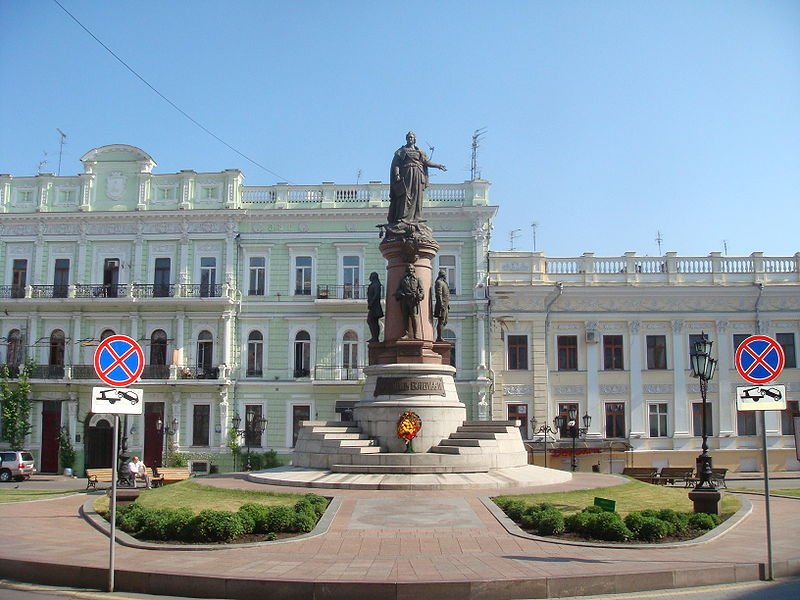 Catherine the Great Square, Odessa
Catherine the Great Square, OdessaSource: https://commons.wikimedia.org/wiki/File:Ekaterininskay_square_Odessa_2010.JPG
Author: HOBOPOCC

Odessa (Ukrainian: Одеса, Russian: Одесса) is a major seaport as well as the fourth largest city in Ukraine. The provincial capital of Odessa Oblast, it is located on the northwest shore of the Black Sea. It covers 236.9 sq km (91.5 sq mi) and has a population of slightly over one million people (2011 estimate), within a metropolitan area of 1.2 million people.
Odessa is in the Gulf of Odessa, which opens into the Black Sea. It is to the north of the mouth of the Dniester river, about 443 km (275 mi) to the south of Kiev. Its location has made it a prime tourist destination today, with many coming here to enjoy its good climate and beaches.
Odessa experiences an oceanic climate bordering on the continental climate and the semi-arid climate. The warmest month is July, when the average high temperature touches 25.9°C (78.6°F). Coldest month is January, when the average low temperature drops to -3.5°C (25.7°F). Odessa gets the most rain in the months of June and July, at 49 mm (1.93 in) respectively. Total precipitation of the year is 440 mm (17.32 in).
Archaeological evidence points to human habitation in the Odessa area as far back as the ancient Greek, which could be as early as the 8th century BC. A settlement was established here by Hacı I Giray, the Khan of Crimea, in 1440. It was originally known as Hacıbey. Shortly after Hacıbey was established, the khan ceded it to Lithuania. Hacıbey remained under Lithuanian control until 1529, when it came under Ottoman rule.
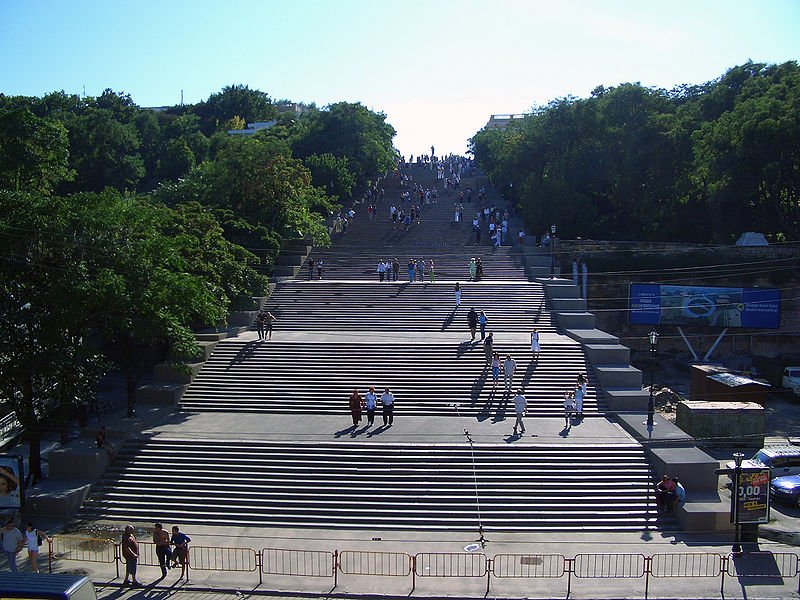 Potemkin Steps, Odessa
Potemkin Steps, OdessaSource: https://commons.wikimedia.org/wiki/File:Potemkinsche_treppe.jpg
Author: Pat Berger

The defeat of the Ottomans in the Russo-Turkish War of 1792 brought Hacıbey and the region surrounding it under Russian rule. Having taken possession of the region, the Russians renamed it Novorossiya or New Russia. In 1794, the Russian empress Catherine the Great founded a new city in Hacıbey and called it Odessa. Due to its favorable location, Odessa was positioned as a seaport.
The founding fathers of modern Odessa are four non-Russians namely French statesman, Armand-Emanuel de Vignerot du Plessis, Duc de Richelieu; French general, Louis Alexandre Andrault de Langeron; Spanish-Irish-born Russian admiral, José de Ribas; and Franz de Volan. The four were instrumental in drawing up the masterplan for the city, and within four years of its founding, made it one of the major cities and seaport in the Russian Empire.
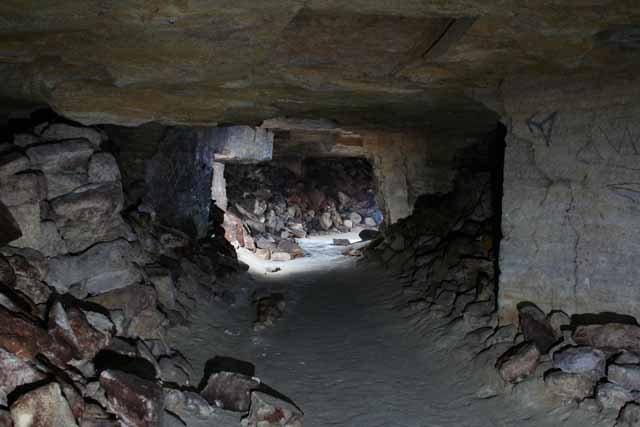 Odessa catacombs
Odessa catacombsSource: https://commons.wikimedia.org/wiki/File:Nerubayskoe_07.jpg
Author: Полищук Денис Анатольевич

Odessa suffered much damage and casualties during the Second World War. Nazi forces occupied the city and killed some 80% of the 210,000 Jews in the region, in what became known as the Odessa Massacre. However the remaining Jews were saved by a change in the policy of the Romanian administration which, upon seeing the Nazis losing ground, refused to allow further deportation of the Jews to extermination camps in German-occupied Poland.
Today Odessa is a modern city within the independent Ukraine. Its economy is based on shipbuilding, oil refinery, food processing, tourism and other industries.
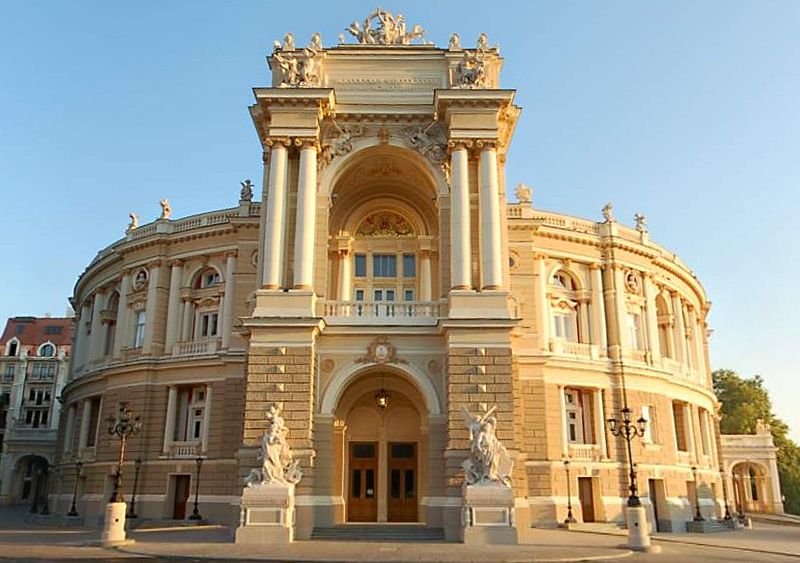 Odessa Opera Theater
Odessa Opera TheaterSource: https://commons.wikimedia.org/wiki/File:Front_view_of_Odessa_opera_theater.jpg
Author: Assedo

Visiting Odessa
Odessa International Airport (ODS) receives flights from Kiev, Budapest, Istanbul, Moscow, Prague, Vienna and Warsaw, among others. There are minibuses (called mashrutka) plying the route between the airport and downtown Odessa. Taking a taxi can be a bothersome hassle, not so much for lack of availability, but due to the high chance of getting ripped off by unscrupulous drivers. Be sure to negotiate a fare before hopping in. A trip to the city center should cost you 50 UAH.Exploring Odessa
The public transport in Odessa comprises the trams, trolleybuses and minibuses (marshrutka). A ride on the tram or trolleybuses will cost you around 2.50 UAH.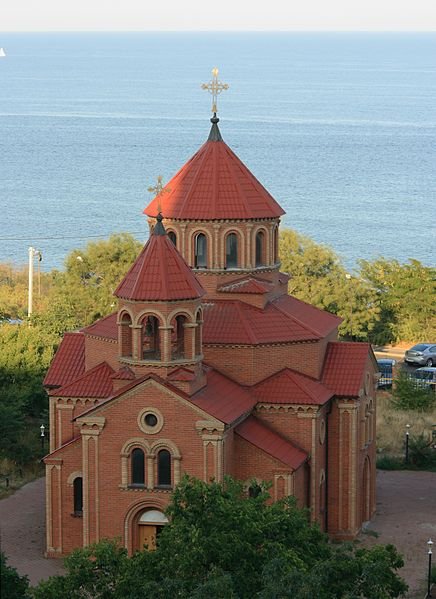 Armenian Church of St Gregory the Illuminator, Odessa
Armenian Church of St Gregory the Illuminator, OdessaSource: https://commons.wikimedia.org/wiki/File:Odessa_St._Gregory_the_Illuminator_Armenian_Church.jpg
Author: Dmitry Klimenko

Sights & Attractions in Odessa
- Alexander Pushkin Museum
Museum providing details about the famous poet Pushkin, who was briefly exiled to Odessa. - Deribasovskaya Street
A spacious pedestrian mall named after Joséde Riba, one of the founding fathers of the city. - Museum of Western & Eastern Art
This is the most important museum in Odessa, with a vast collection of works of art from Europe and the Orient. - Odessa Catacombs
A labyrinthine network of underground tunnels dug in the 19th century. They were the source of limestone as well as a hideway for smugglers. Today these tunnels attract adventurous tourists. Such visits are not officially encouraged as the tunnels have not been fully mapped, and are therefore unsafe. - Odessa Opera & Ballet Theater
Stately historical building completed in 1887 in the Renaissance style. Performances are still staged here regularly. - Potemkin Steps
The most famous sight in Odessa. An optical illusion, the steps designed by Italian architect Francesco Boffo in the 19th century continue to delight visitors every day. - Seventh-Kilometer Market
Outdoor market touted as the biggest market in Europe. It brings 6,000 traders and 150,000 customers every day to the 170-acre site. - Vorontsov's Palace
Another masterpiece by Italian architect Francesco Boffo, it was built for the governor of Odessa, Prince Mikhail Semyonovich Vorontsov.
 Latest updates on Penang Travel Tips
Latest updates on Penang Travel Tips
 Discover with Timothy YouTube Channel
Discover with Timothy YouTube Channel
 PG Food Channel
PG Food Channel
 Learn Penang Hokkien YouTube Channel
Learn Penang Hokkien YouTube Channel
 SojiMart Videos
SojiMart Videos
 Share your travels and/or ask a travel-related question
Share your travels and/or ask a travel-related question
Join the Penang Travel Tips Facebook Group to share photos, tips and anything related to your travels, or ask travel-related questions.
 Map of Roads in Penang
Map of Roads in Penang
Looking for information on Penang? Use this Map of Roads in Penang to zoom in on information about Penang, brought to you road by road. Discover with Timothy
Discover with Timothy
Let me take you to explore and discover Penang through my series of walking tours on YouTube. You may use these videos as your virtual tour guide. At the beginning of each video, I provide the starting point coordinates which you may key into your GPS, Google Maps or Waze, to be navigated to where I start the walk, and use the video as your virtual tour guide.Disclaimer
Please use the information on this page as guidance only. The author endeavours to update the information on this page from time to time, but regrets any inaccuracies if there be any.Latest from Discover with Timothy: Gurney Bay - what to see and do there
About this website

Hello and thanks for reading this page. My name is Timothy and my hobby is in describing places so that I can share the information with the general public. My website has become the go to site for a lot of people including students, teachers, journalists, etc. whenever they seek information on places, particularly those in Malaysia and Singapore. I have been doing this since 5 January 2003, for over twenty years already. You can read about me at Discover Timothy. By now I have compiled information on thousands of places, mostly in Peninsular Malaysia and Singapore, and I continue to add more almost every day. My goal is to describe every street in every town in Malaysia and Singapore.
Robbie's Roadmap
- Episode 1: Robbie's Journey to Financial Freedom
- Episode 2: Lost in America
- Episode 3: The Value of Money
- Episode 4: The Mentor
- Episode 5: The Thing that Makes Money
- Episode 6: The walk with a Billionaire
- Episode 7: The Financial Freedom Awakening
- Episode 8: Meet Mr Washington
- Episode 9: The Pizzeria Incident
Copyright © 2003-2024 Timothy Tye. All Rights Reserved.